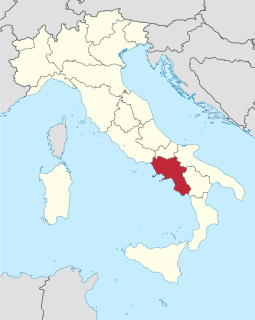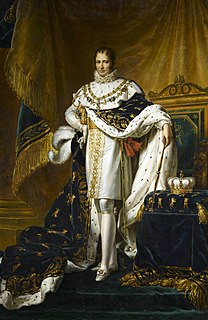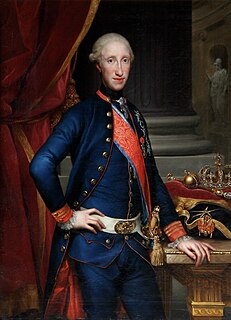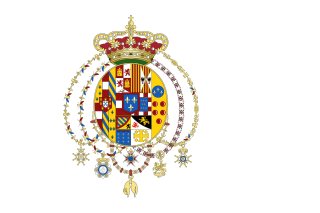
Cesare Calense (died 1640[ citation needed ]) was a native of the province of Lecce in the kingdom of Naples, Italy. He painted a Deposition for the church of St John the Baptist in Naples.

Cesare Calense (died 1640[ citation needed ]) was a native of the province of Lecce in the kingdom of Naples, Italy. He painted a Deposition for the church of St John the Baptist in Naples.

Alfonso the Magnanimous was the King of Aragon and King of Sicily and the ruler of the Crown of Aragon from 1416 and King of Naples from 1442 until his death. He was one of the most prominent political figures of the early Renaissance.

Campania is an administrative region of Italy; most of it is in the south-western portion of the Italian peninsula, but it also includes the small Phlegraean Islands and the island of Capri. The capital of the Campania region is Naples. As of 2018, the region had a population of around 5,820,000 people, making it Italy's third most populous region, and, with an area of 13,590 km2 (5,247 sq mi), its most densely populated region. Based on its GDP, Campania is also the most economically productive region in southern Italy and the 7th most productive in the whole country. Naples' urban area, which is in Campania, is the seventh most populous in the European Union. The region is home to 10 of the 58 UNESCO sites in Italy, including Pompeii and Herculaneum, the Royal Palace of Caserta, the Amalfi Coast and the Historic Centre of Naples. In addition, Campania's Mount Vesuvius is part of the UNESCO World Network of Biosphere Reserves.

Naples is the regional capital of Campania and the third-largest city of Italy, after Rome and Milan, with a population of 967,069 within the city's administrative limits as of 2017. Its province-level municipality is the third-most populous metropolitan city in Italy with a population of 3,115,320 residents, and its metropolitan area stretches beyond the boundaries of the city wall for approximately 20 miles.

Joseph-Napoléon Bonaparte was a French statesman, lawyer, diplomat and older brother of Napoleon Bonaparte. During the Napoleonic Wars, the latter made him King of Naples (1806–1808), and then King of Spain (1808–1813). After the fall of Napoleon, Joseph styled himself Comte de Survilliers and emigrated to the United States, where he settled near Bordentown, New Jersey, on an estate overlooking the Delaware River not far from Philadelphia.

Naples is a city in Collier County, Florida, United States. As of the 2020 census, the city's population was 19,115. Naples is a principal city of the Naples-Marco Island, Florida Metropolitan Statistical Area, which had a population of about 322,000 as of 2015.

Charles III was King of Spain (1759–1788). He also was Duke of Parma and Piacenza, as Charles I (1731–1735); King of Naples, as Charles VII, and King of Sicily, as Charles V (1734–1759). He was the fifth son of Philip V of Spain, and the eldest son of Philip's second wife, Elisabeth Farnese. A proponent of enlightened absolutism and regalism, he succeeded to the Spanish throne on 10 August 1759, upon the death of his childless half-brother Ferdinand VI.

Ferdinand I, was the King of the Two Sicilies from 1816, after his restoration following victory in the Napoleonic Wars. Before that he had been, since 1759, Ferdinand IV of the Kingdom of Naples and Ferdinand III of the Kingdom of Sicily. He was also King of Gozo. He was deposed twice from the throne of Naples: once by the revolutionary Parthenopean Republic for six months in 1799 and again by Napoleon in 1805, before being restored in 1816.

The Parthenopean Republic or Neapolitan Republic was a short-lived, semi-autonomous republic located within the Kingdom of Naples and supported by the French First Republic. The republic emerged during the French Revolutionary Wars after King Ferdinand IV fled before advancing French troops. The republic existed from 21 January to 13 June 1799, collapsing when Ferdinand returned to restore monarchial authority and forcibly subdued republican activities.

The Kingdom of Naples, also known as the Kingdom of Sicily, was a state that ruled the part of the Italian Peninsula south of the Papal States between 1282 and 1816. It was established by the War of the Sicilian Vespers (1282–1302), when the island of Sicily revolted and was conquered by the Crown of Aragon, becoming a separate kingdom also called the Kingdom of Sicily. In 1816, it reunified with the island of Sicily to form the Kingdom of the Two Sicilies.

The Kingdom of Sicily was a state that existed in the south of the Italian peninsula and for a time the region of Ifriqiya from its founding by Roger II of Sicily in 1130 until 1816. It was a successor state of the County of Sicily, which had been founded in 1071 during the Norman conquest of the southern peninsula. The island was divided into three regions: Val di Mazara, Val Demone and Val di Noto; val being the apocopic form of the word vallo, with the administrative meaning of province, from Siculo Arabic: وَلاية, romanized: wālāya, but also used with the geographical meaning of valley, from Latin: vallis.

The Gulf of Naples, also called the Bay of Naples, is a roughly 15-kilometer-wide (9.3 mi) gulf located along the south-western coast of Italy. It opens to the west into the Mediterranean Sea. It is bordered on the north by the cities of Naples and Pozzuoli, on the east by Mount Vesuvius, and on the south by the Sorrento Peninsula and the main town of the peninsula, Sorrento. The Peninsula separates the Gulf of Naples from the Gulf of Salerno, which includes the Amalfi Coast.

Maria Carolina of Austria was Queen of Naples and Sicily as the wife of King Ferdinand I of the Two Sicilies. As de facto ruler of her husband's kingdoms, Maria Carolina oversaw the promulgation of many reforms, including the revocation of the ban on Freemasonry, the enlargement of the navy under her favorite, Sir John Acton and the expulsion of Spanish influence. She was a proponent of enlightened absolutism until the advent of the French Revolution, when, in order to prevent its ideas gaining currency, she made Naples a police state.

Naples International Airport is the international airport serving Naples and the Southern Italian region of Campania. According to 2019 data, the airport is the fifth-busiest airport in Italy and the first one in Southern Italy. The airport serves as a base for easyJet, Ryanair, Volotea and Wizzair. Located 3.2 NM north-northeast of the city in the San Pietro a Patierno quarter of Naples, the airport is officially named Aeroporto di Napoli-Capodichino Ugo Niutta, after decorated WWI pilot Ugo Niutta.

The University of Naples Federico II is a public university in Naples, Italy. Founded in 1224, it is the oldest public non-sectarian university in the world, and is now organized into 26 departments. It was Europe's first university dedicated to training secular administrative staff, and is one of the oldest academic institutions in continuous operation. Federico II is the third University in Italy by number of students enrolled, but despite its size it is still one of the best universities in Italy and the world, being particularly notable for research; in 2015 it was ranked among the top 100 universities in the world by citations per paper. The university is named after its founder Frederick II. In October 2016 the university hosted the first ever Apple IOS Developer Academy and in 2018 the Cisco Digital Transformation Lab.

The Capetian House of Anjou or House of Anjou-Sicily, was a royal house and cadet branch of the direct French House of Capet, part of the Capetian dynasty. It is one of three separate royal houses referred to as Angevin, meaning "from Anjou" in France. Founded by Charles I of Anjou, the youngest son of Louis VIII of France, the Capetian king first ruled the Kingdom of Sicily during the 13th century. Later the War of the Sicilian Vespers forced him out of the island of Sicily, leaving him with the southern half of the Italian Peninsula — the Kingdom of Naples. The house and its various branches would go on to influence much of the history of Southern and Central Europe during the Middle Ages, until becoming defunct in 1435.
Patricia of Naples is an Italian virgin and saint. Tradition states that she was noble; she may have been related to the Roman Emperor. Some sources say that she was a descendant of Constantine the Great. The particulars traditional about her are unreliable and in some instances contradictory.
The Naples Daily News is the main daily newspaper of Naples, Florida, and Collier County. It is owned by Gannett and has a circulation of more than 40,000.

The Kingdom of the Two Sicilies was a kingdom in Southern Italy from 1816 to 1860. The kingdom was the largest sovereign state by population and size in Italy before Italian unification, comprising Sicily and all of the Italian Peninsula south of the Papal States, which covered most of the area of today's Mezzogiorno.

The Kingdom of Naples was a French client state in southern Italy created in 1806 when the Bourbon Ferdinand IV & VII of Naples and Sicily sided with the Third Coalition against Napoleon and was in return ousted from his kingdom by a French invasion. Joseph Bonaparte, elder brother of Napoleon I, was installed in his stead: Joseph conferred the title "Prince of Naples" to be hereditary on his children and grandchildren. When Joseph became King of Spain in 1808, Napoleon appointed his brother-in-law Joachim Murat to take his place. Murat was later deposed by the Congress of Vienna in 1815 after striking at Austria in the Neapolitan War, in which he was decisively defeated at the Battle of Tolentino.
| Wikimedia Commons has media related to Cesare Calense . |